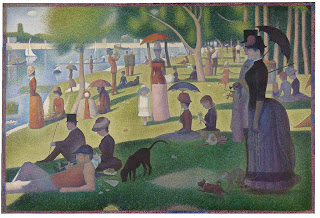The Ballet Class by Edgar Degas was painted between 1871 and 1874. From 1870 until his death in 1917, the artist's favorite subject were ballerinas, either rehearsing or not. One of his friends played in the orchestra in the Paris opera house, so Degas was introduced to the backstage area of the opera. He would spend much time there.
What I really like about this painting, just like others by Degas, is that everything looks very natural. I don't know whether or not this is true, but it doesn't look like the dancers were posing for the painting. It seems as though none of them notice that the artist is there, painting.Another major part of this painting that I noticed was the room that they are in. Not nearly every dance studio has marble columns used as accents! Some surprising details of the painting include the watering can and Yorkshire Terrier in the bottom left corner. I wonder how those got into the dance studio...
Another thing I realized, after reading the following quote, was how good the floor looks. It's not the dominant element in the painting, but it looks very real. The wide floorboards, just like many old buildings have, make the painting look very authentic.
Degas is one of the very few painters who gave the ground its true importance. He has some admirable floors.
-Paul Valéry








